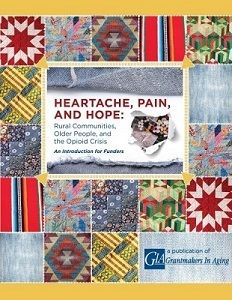
It would be easy to look at the steady stream of reporting on the opioid crisis and conclude that the problem is all about addiction. Certainly the cost in lives lost has been unacceptably high -- more than 183,000 deaths in the last ten years. (More statistical background is available here.)
But the opioid crisis is the story of many kinds of pain and it is about more than addiction.
What is getting lost is the impact this epidemic is having on a wide circle of people who are not addicted. It is affecting people in every age group – children, parents, grandparents, and entire communities, particularly small and rural communities. It is creating chaos in communities that are struggling to cope with the fallout in child welfare, elder abuse, public safety, criminal justice, the workforce, the economy, caregiving, housing, and, of course, health care.
There’s no question we need to work together on solutions. But whether we are health care providers, policymakers, communities, or funders, we first need to widen the lens we are using to consider the problem.
A Problem that is Getting Older

The needs and concerns of older people very rarely get any attention in discussions about the opioid problem. This needs to change, for several reasons.
While older people do not have the highest rate of opioid-related deaths (the age group hardest hit is adults 45 to 54), they are far from immune. There is also emerging evidence that Medicare patients have some of the highest and fastest-growing rates of opioid use disorder (UOD), with hospitalizations increasing by 10 percent per year.
Younger people struggling with these drugs now are likely to have problems throughout their lives, so we can predict a large cohort of older people with an opioid history in the coming years.

Most importantly, one need not be addicted to be hurt. Older people are often drawn into the struggles of addicted children, friends, and extended family. The growing number of grandparents raising the children of addicted parents in “grandfamilies” has paralleled the growth of the epidemic, according to Generations United.
Many older people are also desperate to keep a struggling family member afloat. Too often, the result of these valiant efforts to hold a family together is older members going down with the ship. By sheltering an addicted child or grandchild in public housing, an older adult risks eviction under anti-drug use regulations from the Department of Housing and Urban Development. Their personal safety may be also be at risk; a rise in elder abuse and financial exploitation is attributed to the opioid crisis, as more adult children with addiction problems move back in with their parents.
Older people’s concerns must be part of a comprehensive solution, including:
- Support for those who take on responsibilities such as raising grandchildren.
- Elder abuse and mistreatment, and offering efforts on stronger prevention and intervention.
- High rates of chronic pain, and the scarcity of good alternatives to opioids for treatment.
- The reluctance to seek help that many older people feel, due to cultural and generational sensitivities.
Remembering Rural Needs

Small towns and rural places – home to about one out of four older Americans -- are feeling some of the worst impact. Rural communities tend to be cohesive and self-reliant, but their infrastructure and resources are often limited, and they are frequently overlooked -- a dangerous mix when it comes to opioids.
Once again, the harm to people in rural America is not limited to addiction, so the solutions for these communities can’t be limited to this, either.
Chronic Pain and the Unintended Consequences of Reform

The medical community has begun to respond, in part by re-thinking prescribing practices and limiting access to opioids. This is an important step, since leftover medications often fall into the wrong hands and cause trouble.
It is just as important to note, however, that chronic pain is a legitimate problem, particularly for a high percentage of older people and for rural residents who may have suffered work-related injuries from physically demanding jobs like coal mining and farming.
For that reason, sweeping restrictions on opioid access are not being universally cheered by geriatricians.
“I think the policies and procedures we are putting in place are going to increase the well-established and sizable number of older people who do not have pain adequately treated,” says Cary Reid, MD, PhD, director of the Office of Geriatric Research in the Division of Geriatrics and Palliative Medicine at Weill Cornell Medical College, and director of Cornell’s Translational Research Institute on Pain in Later Life. “We need to recognize that the line between palliative care and chronic disease care can be blurry in older patients.”
Clearly this need cannot be ignored - a concern echoed in a new study, Pain Management and the Opioid Epidemic: Balancing Societal and Individual Benefits and Risks of Prescription Opioid Use, from the National Academies of Sciences, Engineering, and Medicine.
Building on Proven Approaches: Resources for Philanthropy
This epidemic offers numerous entry points for funders of all kinds and sizes. The potential for meaningful impact is great, in part because surprisingly little has been done so far.
Because the problem is multi-systemic and many communities are overwhelmed, it is unusually important for funders to take the initiative, says Allen Smart, who worked on the opioid problem while vice president of programs and interim president at the Kate B. Reynolds Charitable Trust and now serves as project director for a study on rural philanthropy practice at Campbell University in North Carolina. “Funders are in a unique position to listen, digest, and bring the best thinking to the table because of our broad interests in rural communities.”

One resource funders can consult to get started is Heartache, Pain, and Hope: Rural Communities, Older People, and the Opioid Crisis: An Introduction for Funders, which was produced by the organization I lead, Grantmakers In Aging, for exactly this purpose.
The guide can help funders become familiar with the issue, and offers descriptions of a wide range of programs that are already working, including:
- The National Family Caregiver Support Program, and Kinship Navigator programs, to help grandfamilies get the full range of legal and financial options, information, and support they need.
- Programs like IAMNDN, which builds intergenerational ties between Native American elders and youth to help combat the culture of drug abuse.
- Counseling services tailored to the needs and preferences of older people, such as Senior Hope Counseling in Albany, NY.
- Telepain consults, which use telemedicine to connect providers from rural, tribal, and medically underserved areas with pain medicine specialists.
To tackle such a large and multi-faceted problem, we must widen our lens and consider the needs of all the people swept up in it. It’s the only way we can make meaningful progress meeting the needs of both individuals and communities in pain.
